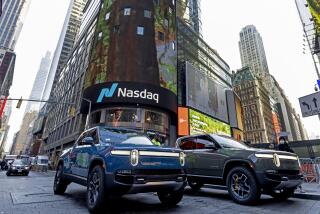Sputtering Renault Faces a Major Overhaul to Get It Running Again
- Share via
PARIS — In 1914, during the first months of World War I, the French used 600 Paris taxis to ferry troops to the Battle of the Marne, halting the advance of the German army 20 miles from Paris. The taxis were all made by the Renault automobile company and ever since, Renault has had a special place in French history.
So many dramatic events have taken place at Renault over the years that a former president once called it “the greatest theater in France.” But today the drama is a depressing one. Renault, showing the largest losses of any corporation in French history, has announced plans to cut its work force by 21,000 in two years, a loss of more than one job in every five.
Just a few years ago, when the Socialist government of President Francois Mitterrand came to power in France, Renault, which had been nationalized at the end of World War II, was hailed as the model of state-run industry, the leading car producer of Europe. Now it is derided by conservatives outside government as the symbol of all that can go wrong with nationalization.
Union Balks at Cuts
To make matters worse, the strongest union at Renault, the communist-run General Confederation of Labor, has refused to accept the company’s plan to eliminate jobs.
“The directors of Renault and the government,” said Andre Sainjon, who leads the union’s auto workers, “have found themselves completely isolated.” Without explicitly threatening a strike, he said the union would consult the workers in the next three months about the kind of action needed to fight the plan.
The job-cutting plan came from Georges Besse, a 57-year-old engineer appointed by the government last January to turn Renault around. He was named after Mitterrand proclaimed his dissatisfaction with Renault in a nationally televised interview. The company had lost a record 12.5 billion francs ($1.38 billion) in 1984, 10 times what it had lost the year before.
Mitterrand made it clear that Bernard Hanon, then Renault’s president, had to go. Within days, newspapers reported rumors that Besse, who helped manage France’s nuclear energy industry in its early days and had a reputation as a tough administrator of nationalized corporations, would soon take over.
Returned for Battle
When Hanon heard these reports, he flew home immediately from the United States, where he had been attending a board meeting of American Motors, owned 46% by Renault. Hanon’s speedy return to battle for his job proved futile. He quickly bowed to the inevitable and resigned.
Under French law, a corporation cannot simply lay off workers to cut costs. It is widely assumed in France that a worker, once dismissed, will never get his job back, even if the plant should resume full production. Since these dismissals are regarded as permanent, the French government must approve them. A long process is involved.
As a first step, Besse presented his plan last Monday to a meeting of union officials. He spoke while the situation continued to worsen at Renault. Statistics showed that car production dropped 10% in the first four months of the year.
Besse told the union officials that Renault’s labor force in France, which totalled 98,000 at the end of 1984, would have to be reduced to 77,000 by the end of 1986. Renault’s oversized labor force, according to Besse, made the company inefficient, handicapping it in competition with foreign manufacturers.
Besse insisted that most of the drop in jobs would come from volunteers for early retirement and foreign workers accepting a program that paid them a bonus and their passage home. But he acknowledged that even with these retirements and resignations, Renault would still have to remove 2,000 other workers from the payroll this year and 5,500 others in 1986.
Dismissals Expected
He did not make it clear how this would be done, and he talked vaguely of finding other employment for workers. But the unions feared that dismissals would be the only real way of making the cuts.
Many union officials, knowing the problems of Renault, muted their criticism of the Besse plan. But confederation leaders did not. Their attacks fell into line with the Communist Party’s intensifying campaign against the ruling Socialist Party in advance of next year’s legislative elections.
In his presentation, Besse outlined other changes at Renault, including the appointment of new managers in key positions. But he did not propose the closing of any plants, and said nothing about abandoning Renault’s investment in troubled American Motors, which some analysts regard as a drain on funds.
Although American Motors has started to show a profit after several years of losses, it has needed more than a half-billion dollars of capital from Renault. Aside from its huge holdings in American Motors, Renault has a 40% interest in Mack Trucks, a producer of large trucks based in Allentown, Pa.
Partly because he played a key role in arranging these heavy American investments in 1981, and partly because of his mathematics degree from Columbia University, Hanon was known in the industry as “the American.” He took over in 1981 at a time when Renault was riding high, phenomenally successful in the 1970s because of the sales throughout Europe of its small, low-priced, fuel-efficient Renault 5. By 1975, Renault had become Europe’s largest auto maker--outdistancing even West Germany’s giant Volkswagen, and it remained on top until the end of the decade. Now it has dropped to sixth place.
Failed to Change
In retrospect, analysts conclude that Hanon and Renault, while on an expansion program, stayed too long with their successful model and failed to introduce a new small model to appeal to new tastes in France and in Europe.
By the time its replacement, the SuperCinq (Super Five), was introduced late last year, Peugeot, France’s biggest privately owned auto maker, had captured the small car market with its new 205. On top of this, the analysts say, the SuperCinq is not different enough from the old Renault 5 to strike the fancy of most French consumers.
Renault also was badly hurt by other problems that have damaged the French car industry as a whole: the competition throughout Europe from Japanese and other non-French manufacturers, the increase in labor costs caused by the Socialist government’s imposition of longer vacations and a shorter work week, and the government’s program of austerity, which cut the purchasing power of French customers.
Hanon’s troubles were compounded by strikes last year when the unions refused to accept a layoff plan that was milder than the one now proposed by Besse.
Whole Industry Hurt
Many of these problems affected the entire car industry in France and, in fact, the rest of Europe as well. Peugeot, too, is losing money, though not at Renault’s rate. In a special report commissioned by the government, Francois Dalle, one of France’s most respected business administrators, warned last October that the French car industry would have to cut out 74,000 jobs by the end of 1988 to recover from its present crisis. Some analysts now believe that Hanon had little chance of leading Renault to profits and that he lost his job because the government needed a scapegoat.
Renault had its beginnings in 1898, when 21-year-old Louis Renault persuaded his father, a rich button manufacturer in Paris, to finance his construction of the new vehicles known as “automobile carriages.”
In a few years, Renault cars scored some spectacular successes in European races, and the company began building its factory in Billancourt, a suburb of Paris alongside the Seine River. Billancourt is still the site of Renault headquarters and of its main plant.
After World War I, Renault became a huge manufacturing corporation, with Louis Renault regarded as one of the most powerful capitalists of France. But all this dissipated after World War II. Louis Renault was jailed for having sold materials to the German military during the war. He died a month later at the age of 67, and the government of Gen. Charles de Gaulle took over the Renault company.
Used Immigrant Labor
Renault was one of 15 companies nationalized by the French government after the war, and it was long regarded as the most successful, reaching a pinnacle in the 1970s. During this period of great expansion, Renault built up a labor force with a heavy percentage of immigrant labor.
Foreign workers are still much in evidence. At Billancourt, West Africans in their long robes can be seen resting on benches after work. Vendors sell cassettes of popular North African singers.
The large percentage--some say it is almost half--of immigrants among the Renault workers may ease the political problems caused by layoffs. Some French may look on any Renault dismissals as a remote, basically foreign problem that really does not concern them.
RENAULT’S RECENT ROAD
Car & Truck Work Force Year Production (In France) 1970 1,159,745 93,672 1975 1,391,948 100,147 1979 1,899,470 106,740 1980 2,053,677 NA 1983 2,072,193 103,000 1984 1,780,816 98,000
% of % of French European Year market market 1979 NA 13 1980 41 15 1981 NA 14 1982 NA 15 1983 35 13 1984 31 11
More to Read
Sign up for Essential California
The most important California stories and recommendations in your inbox every morning.
You may occasionally receive promotional content from the Los Angeles Times.













